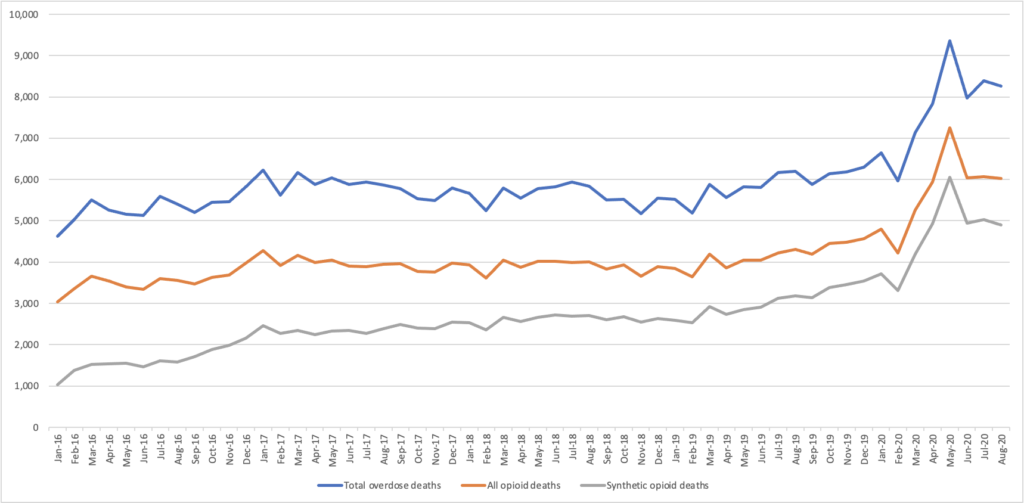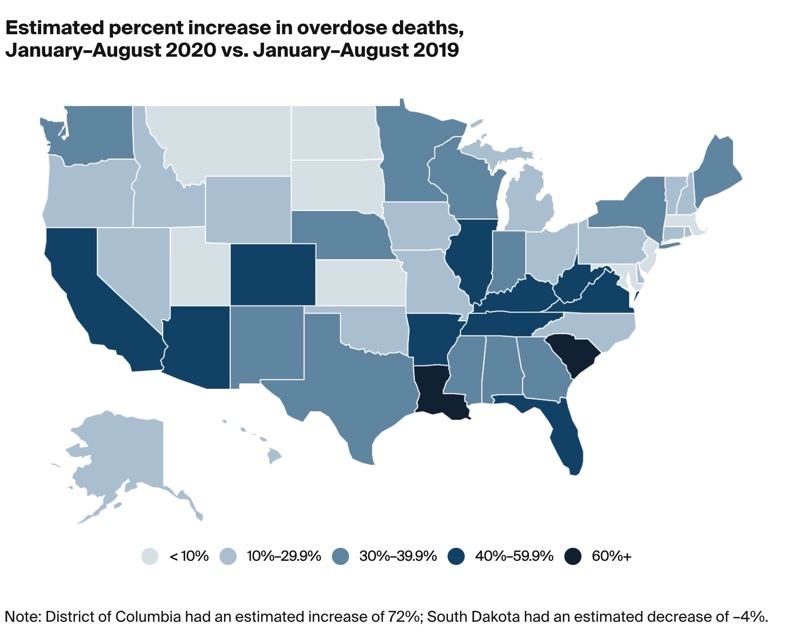Overdose deaths grew 33 percent nationally in first 8 months of 2020
Last year in Minnesota, overdose deaths were up 27 percent from 2019. This is an unfortunate trend that has been hugely caused by COVID-19 restrictions that perpetrated isolation and kept individuals from accessing needed services. Nationally, the trend has been the same.
According to data provided by the National Vital Statistics System, between October 2019- October 2020, the United States experienced 88,990 overdose deaths. This is about 28 percent more than the deaths experienced between October 2018 to October 2019.
In an analysis of preliminary data, researchers at the Commonwealth Fund had the following to say about overdose deaths in the United States, between August 2019 to August 2020.
Our estimates show that total overdose deaths spiked to record levels in March 2020 after the pandemic hit. Monthly deaths grew by about 50 percent between February and May to more than 9,000; they were likely still around 8,000 in August. Prior to 2020, U.S. monthly overdose deaths had never risen above 6,300.
Opioid-related deaths drove these increases, specifically synthetic opioids such as fentanyl. Opioids accounted for around 75 percent of all overdose deaths during the early months of the pandemic; around 80 percent of those included synthetic opioids.
The Commonwealth Fund additionally estimated back in March that based on CDC’s weekly estimates, total overdose deaths in 2020 could total over 90,000 which “would not only be the highest annual number on record but the largest single-year percentage increase in the past 20 years.”
figure 1: Monthly overdose deaths

Source: The Commonwealth Fund
Generally, compared to the same period in 2019, during the first 8 months of 2020,
Overdose deaths increased in almost every state; 24 states and the District of Columbia had an estimated increase of at least 30 percent, and the overall U.S. total increased by 33 percent.
States like West Virginia and Kentucky have long been at the heart of the opioid epidemic, and that region is still reporting some of the largest proportional increases. Recent research has also highlighted the growing impact of fentanyl and overdose deaths within states farther West. Arizona, California, Colorado, Illinois, Texas, and Washington all experienced increases above 35 percent during the first eight months of 2020; Colorado recently reported record overdose deaths during full year 2020.

Young people face a significantly smaller risk of dying from COVID-19 than from overdose, as illustrated by the Minnesota data.
In 2020, 274 individuals aged 25-34 died from an overdose, while only 15 died from COVID-19. To put it in perspective, individuals aged 25-34 were 18 times more likely to die from overdose than from COVID-19. It is similar with individuals aged 35-44, although to a lesser extent –– individuals in this group were 4 times more likely to die from overdose than COVID-19 in 2020.
The biggest discrepancy in risk is among individuals aged 15-24 –– they were 40 times more likely to die from an overdose than from COVID-19. Generally, on average, individuals age 54 and younger had about 4 times the risk of dying from overdose than from COVID-19.
On the other hand, in 2020, about 2398 people 85 and over died from COVID-19 compared to just 10 from an overdose, meaning people in this age group were 240 times more likely to die from COVID-19 than from overdose. individuals aged 65-74, and 75-84 were about 20 and 200 times more likely to die from COVID-19, respectively.
Yet, social distancing rules and stay-at-home orders, without taking that into account the increased likelihood of drug use and abuse, consequently increased overdose deaths.